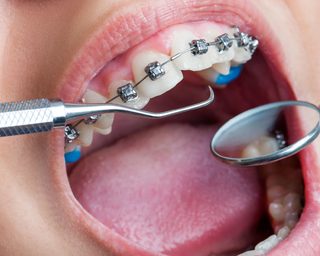What is
Orthodontics?
Orthodontics is a branch of dentistry that treats malocclusion, a condition in which the teeth are not correctly positioned when the mouth is closed. This results in an improper bite.
An orthodontist specializes in making the teeth straight.Treatment can be cosmetic, to improve a person’s appearance, but it often aims to improve oral function, too.
Abnormal alignment of the teeth and jaws is very common. Nearly 50% of the developed world’s population, has malocclusions severe enough to benefit from orthodontic treatment.
Conclusive scientific evidence for the health benefits of orthodontic treatment, however, is lacking, although patients with completed orthodontic treatment have reported a higher quality of life than that of untreated patients undergoing orthodontic treatment.
Treatment may require several months to a few years, and entails using dental braces and other appliances to gradually adjust tooth position and jaw alignment. In cases where the malocclusion is severe, jaw surgery may be incorporated in the treatment plan.
Treatment usually begins before a person reaches adulthood, insofar as pre-adult bones may be adjusted more easily before adulthood.
We’ll make you proud of your smile.
How Do
Orthodontic Treatments Work?
Orthodontic treatments involve different types of appliances used to retrain muscles, slowly move teeth, and affect your jaw’s growth by placing gentle pressure on your teeth and jaw.
Fixed vs. Removable Appliances
Orthodontic treatments could involve fixed or removable appliances. Depending on how severe your situation, your orthodontist will advise you on which approach is the right one for you.
Fixed appliances include:
- Braces – You’ve most likely heard of braces – they’re the most common fixed appliance. They consist of bands, wires, and brackets. How do they work? The bands are the anchors held in place around your teeth. Brackets are attached to the front of your teeth. Arch wires connect the brackets to the bands. Tightening the archwires puts pressure on your teeth, slowly moving them towards their target position. Braces are usually adjusted monthly and are worn for a few months to a few years.
- Special fixed appliances – These should only be used as a last resort to control thumb sucking or tongue thrusting. Since they’re attached to the teeth by bands, they can feel quite uncomfortable while eating.
- Fixed space maintainers – Sometimes, young children lose their teeth prematurely. In such situations, an orthodontist might place a space maintainer in your child’s mouth to keep the space open until a permanent tooth appears.
Removable appliances include:
- Aligners – These are increasingly becoming a popular alternative to traditional braces for adults. Aligners move teeth in the same way as braces, but they are virtually invisible and don’t involve metal wires and brackets. If you’re using them, you need to remove them while eating, brushing, and flossing.
- Removable space maintainers – These devices are used for the same reason as fixed space maintainers. They’re made up of plastic or wire branches and an acrylic base that fits over the jaw. They’re placed in open spaces between teeth to keep the teeth apart.
- Jaw repositioning appliances – These appliances are also known as splints. They’re placed either on the top or lower jaw and are used to treat TMJ disorders by training the jaw to close in a better position.
- Lip and cheek bumpers – Your lip and cheek muscles might exert pressure on your teeth. In such cases, you can use bumpers to keep your lips and cheeks away from the teeth.
- Palatal expander – This device is a plastic plate that fits over the roof of the mouth. It’s used when the arch of your upper jaw needs to be widened.
- Removable retainers – These devices, worn on the roof of the mouth, prevent your teeth from shifting back to their previous position.
- Headgear – These devices slow down the growth of the upper jaw. They also hold the back teeth in place while the front teeth are pulled back.
Orthodontic
Treatments
However only your orthodontist can correctly determine which orthodontic treatment is right for you. Using diagnostic tools such as clinical exams, plastic models of your teeth, and X-rays, orthodontist will develop a treatment plan that works for you and your teeth.
We know that there is a lot to consider while looking at possible orthodontic treatment plans. But now that you know more about what orthodontics is, why it’s important, and how it works, we hope you’re well on your way to experiencing its benefits for yourself and we are ready to answer you for any kind of uncertainty you may have!



